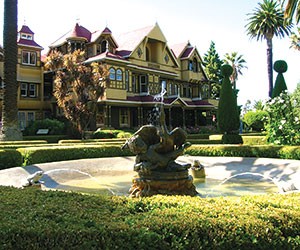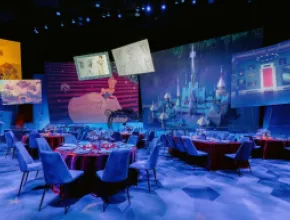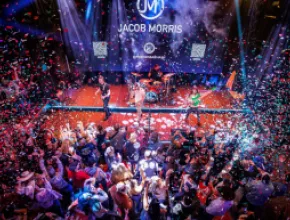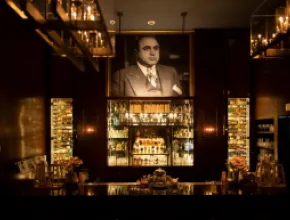Ever want to build a solar system, crawl through a tactile dome or explore your own mind? Science centers and interactive museums across the country are a great option for planners who want to spice up a meeting with interactive playtime.
While the hands-on museum is not a totally new concept—it started with Munich’s Deutsches Museum, which debuted in the early 20th century as a prototype for the modern interactive science museum—the concept didn’t take off in the U.S. until after Chicago’s Museum of Science and Industry, which opened in phases between 1933 and 1940, came on the scene.
"The field of science centers and museums is relatively new," says Sean Smith, director of government and public relations for the Association of Science-Technology Centers, who estimates there are 350 science centers and museums in the U.S. "It started after the space race and Sputnik era. Now there is a leveling off.
"I think especially now more than ever there is such an emphasis on science, technology and math education," he adds. "You hear it from the White House down. To be able to expose people to that in an out-of- school type of setting is something unique. Our science centers and museums are trying to offer more to older audiences."
San Francisco’s Exploratorium
One of the country’s premier interactive museums is San Francisco’s Exploratorium, founded in 1969.
"One of the benefits of having an event at an institution like ours is private access to our exhibit collections," says Amy Adkins, museum rentals manager. "Groups can tinker with hundreds of exhibits, network over the exhibits or have a glass of wine and hors d’oeuvres while still enjoying the exhibits."
With over 400 exhibits at the museum, there is a lot to explore,
"We have great collections on listening, exploring how we think… life sciences, electro magnetism," Adkins says. "Many of the exhibits are designed to involve more than one person, and can allow groups to network, such as building an arch together, moving a giant pendulum using small magnets."
The Exploritorium, housed within the Palace of Fine Arts, which was built for the 1915 Panama-Pacific International Exposition, can host a standing reception for up to 2,500 and seated dinners of 400. Small groups of seven at a time can take a behind-the- scenes tour, showing where exhibits are designed and built.
Groups can start the evening off in the mezzanine for a cocktail hour, among a collection of life sciences exhibits, and then come to the main floor’s skylight area for a seated dinner. The 150-seat McBean Theater is also open for presentations and events.
Tacoma’s Museum of Glass
Tacoma’s Museum of Glass offers tours of the museum, including a stop in the Hot Shop Amphitheater, where guests can watch artists blowing glass.
After-hours, the space is open for group events.
"We offer an event called Hands-On Glass in the hot shop. Ten to 30 people can blow glass, make their own paperweight or ornament or small trinket. There is instruction but it’s not like a class. They can have artists come and work with everybody and show them what to do and how to shape it," says Liza Holbrook, event services manager for the museum. "We’ve advertised it as team building. Companies bring clients or employees for the hands-on. We don’t do competitions. They might do that when they get the pieces back."
The museum offers groups its Grand Hall, which is the general lobby area that can be transformed into event space, and can seat 300 for dinner or accommodate about 500 for receptions. The galleries themselves cannot be used for receptions, but do stay open during events for docent-led tours after-hours.
In addition, groups can use any of the museum’s three outdoor plazas for cocktails. The Main Plaza is a 3,900-square-foot venue adjacent to the museum’s largest reflecting pool, while the 4,200-square-foot mezzanine plaza overlooks the Thea Foss Waterway and esplanade and is bordered by one of the museum’s reflecting pools. The museum’s Rooftop Plaza offers views over Tacoma’s restored historic district, Mount Rainier and the Olympic mountain range. The 5,400-square-foot plaza is the largest of the museum’s outdoor venues.
Oregon Museum of Science and Industry
In Portland, Ore., the Oregon Museum of Science and Industry can accommodate up to 2,500 for a reception or up to 750 for a banquet. Exhibit halls are open for receptions and each hall presents a different theme, such as life sciences and earth sciences. The Turbine Hall lets guests build an aqueduct and program a robot or feel an earthquake.
Groups can use the auditorium, outdoor courtyard or the Copeland Dining Room for dinners and receptions.
Chicago’s Museum of Science and Industry
Chicago’s Museum of Science and Industry remains one of the preeminent museums of its kind. It’s one of the largest science museums in the world, with more than 35,000 artifacts and nearly 14 acres of hands-on exhibits.
Aside from groups taking part in the interactive ventures, the museum is known for its signature themed events. With the program "Exploring the Inventive Genius in You!," groups are greeted by a life-size robot leading to the rotunda where participants are transported into a futuristic cyber-lounge. Mixologists pour fruit-infused martinis to the sounds of a DJ. Groups can explore the museum’s exhibits and may encounter Mr. Slick, a human oil droplet mime at Petroleum Planet, the Master of Wheels at the Great Train Story or NetWorld’s Fiber-Optic Man.
Groups of up to 5,000 can be accommodated for a cocktail reception throughout the entire museum, or groups can host a dinner in the rotunda space, a reception in the lagoon area or a reception on the front lawn. Exhibits such as the U-505 submarine, the only German U-boat in the U.S., and the Henry Crown Space Center can host receptions. At the space center, guests mingle alongside the original Apollo 8 Command Module, the Aurora 7 Mercury Space Capsule and the Lunar Module trainer.
D.C.’s International Spy Museum and Newseum
Groups tap into their inner Sherlock Holmes at The International Spy Museum, in Washington, D.C. One of the most popular options is Operation Spy, led by a faux spy who helps coordinate a mission to save the world from nuclear destruction. The challenge combines live-action, special effects and hands-on activities like cracking a safe, decoding messages and conducting a polygraph test of a suspect agent.
For exclusive evening use of the facility, the Spy at Night program incorporates the basics of Operation Spy in a clandestine setting, and adds cocktails to the mix. Participants test their speed at deciphering secret messages on a super-sized cipher wheel.
Another option, Spy in the City offers a GPS guided tour of the city’s Penn Quarter, following the story of a terrorist plot. Up to four people can share each GPS device, creating the scenario for a team-building competition to save the city from a terrorist attack.
"All of those things can be packaged with a food and beverage opportunity," says Karen Corbin, CEO of the International Spy Museum.
Groups can also create a special package any evening but Friday or Saturday, including activities such as a scavenger hunt. The Spy Cafe or Zola Wine and Kitchen are available for dinners or receptions. Zola’s test kitchen, visible from two large "spy holes," can hold 30 people for a sit-down occasion or 50 for cocktails.
"They can have a Julia Child spy-themed cooking class. Julia Child spent a couple of years as a spy," Corbin says. "The executive chef can do a demonstration of Julia Child recipes and we also have an impersonator. Everyone can sample the fixings."
Another of D.C.’s interactive venues, the Newseum is a 250,000-square-foot museum focused on news and current affairs, which can host up to 3,500 for a reception. The Newseum offers seven levels of galleries, exhibits and theaters. Visitors to the Great Hall of News are surrounded by a continuous flow of news while the NBC News Interactive Newsroom offers visitors a chance to play the role of a reporter or photographer.
Touch-screen stations provide the reporting tools and techniques needed to see what it takes to be a photographer or newspaper reporter. There are also eight "Be a Reporter" stations where guests can pick up a microphone, step before a camera and experience what it’s like to be a television reporter.
Different backdrops for the broadcast are available, such as the White House or basketball court at Verizon Center.
"Guests can walk away with a photo of them doing the news and when they go home download a video of them doing the news," says Pam Galloway-Tabb, vice president of general services for the Newseum.
Other options include playing a fast-paced NewsMania game that tests knowledge of news events. Exhibits include the Pulitzer Gallery, Ethics Gallery and 9/11 gallery. The concourse level has an FBI exhibit as well as a Red Cross exhibit. All spaces can be used for events and receptions.
The 90-foot-high Newseum atrium can seat up to 500 for a dinner. Many groups host cocktails and hors d’oeuvres in the Front Pages Gallery and then take in the views from the terrace.
"One of the great things about the Newseum space are the three glass elevators, or Partyvaters," Galloway-Tabb says.
Guests travel 101 feet in a floor-to-ceiling glass elevator. Each holds 50 guests, and groups can place lighted bars in each elevator and serve cocktails and hors d’oeuvres made from recipes by Wolfgang Puck. The 24,000-square-foot Knight Conference Center sits above the Newseum, featuring two levels, each with its own private terrace and views of the city.
Science Museum of Virginia
One of the country’s premiere science museums, the Science Museum of Virginia, founded in 1970 in Richmond, Va., is housed in the former Broad Street train station, and was designed by John Russell Pope, the designer of the Jefferson Memorial. Hands-on exhibits cover life sciences and physics, and the museum features various demonstrations, such as its exhibit of rats trained to play basketball.
"We like to take science into everything we can," says Karen McKenzie, who works in guest operations for the museum.
The museum offers science demonstrations as well as museum-wide scavenger hunts that allow for team building.
McKenzie also notes that the museum features a number of areas for receptions. For dinners, the most used location is the rotunda, home to one of the museum’s most popular exhibits, the Foucault pendulum. Another dining option is the museum’s restaurant, the RF&P Forum, originally Broad Street Station’s dining room, which can host up to 100 for dinners or 150 for receptions. Larger spaces include the Thalhimer Pavilion and the outdoor Garner Pavilion. Other smaller options include the Discovery Room and the museum’s Imax
theater.
Fort Worth Museum of Science and History
One of the newest additions to the list of science museums will be the Fort Worth Museum of Science and History, scheduled to open in late November in Fort Worth, Texas. Exhibits will include the 10,000-square-foot Energy Gallery focusing on the energy story of Fort Worth and northern Texas.
Focal points of the museum will be the 7,600-square-foot Innovation Studios and the Innovation Gallery, both located in the center of the first floor. The Innovation Studios comprise five interactive, illuminated spaces where guests will learn about science and history topics—from nanotechnology research to space travel.
Venue space will include a special events room, atrium and central courtyard. The special events room will accommodate up to 350 people. Just outside the room, the museum’s main courtyard will feature a 40-foot canopy and water element. The 4,450-square-foot space also will include sitting areas.







